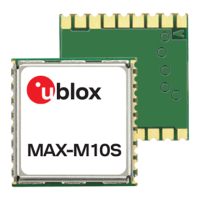
Do you have a question about the Ublox MAX-M10S and is the answer not in the manual?
| Supported Constellations | GPS, GLONASS, Galileo, BeiDou |
|---|---|
| Velocity Accuracy | 0.1 m/s |
| Time Accuracy | 30 ns |
| Update Rate | 10 Hz |
| Navigation Sensitivity | -167 dBm |
| Sensitivity (Acquisition) | -148 dBm |
| Hot Start Time to First Fix | 1 s |
| Aided Start Time to First Fix | 2 s |
| Operating Voltage | 1.65 V to 3.6 V |
| Receiver Type | GNSS |
| Frequency Bands | L1 |
| Positioning Accuracy | 2.5 m |
| Tracking & Acquisition Sensitivity | -167 dBm |
| Cold Start Time to First Fix | 26 seconds |
| Power Consumption (Power Save Mode) | 5 mW |
| Interface | UART, SPI, I2C |
| Operating Temperature | -40°C to 85°C |
Provides a general overview of the MAX-M10S receiver's capabilities.
Describes the internal structure and key functional blocks of the receiver.
Details the function and layout of each pin on the MAX-M10S module.
Explains how to configure receiver settings for various applications and modes.
Covers SBAS and QZSS SLAS for enhanced GNSS correction data.
Describes UART, I2C interfaces and Programmable Input/Output pins.
Details the antenna supervisor feature and its implementations.
Explains how to force a receiver reset and the different reset types.
Outlines the security features for the air interface and host system.
Describes power saving modes like PSMCT and PSMOO for reduced power consumption.
Explains how the receiver maintains local time and GNSS time bases.
Details the power supply pins (VCC, V_IO, V_BCKP) and their requirements.
Discusses in-band and out-of-band interference affecting GNSS signal reception.
Describes the receiver's RF front-end design, LNA modes, and immunity.
Provides guidelines for PCB layout, grounding, and component placement for optimal GNSS performance.
Covers ESD precautions and general safety measures for handling the module.
Details packaging, reels, tapes, and moisture sensitivity levels (MSL).
Provides recommendations for reflow soldering procedures and paste.
Highlights key hardware and software changes when migrating from MAX-M8 to MAX-M10S.
Presents reference designs for typical applications and antenna supervisor circuits.
Lists recommended external components like capacitors, resistors, and inductors.
